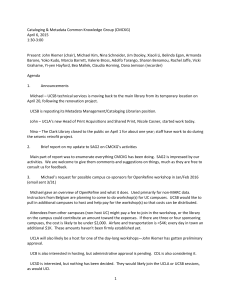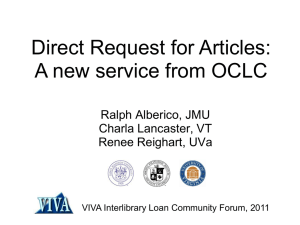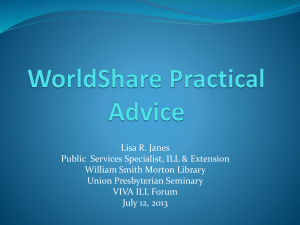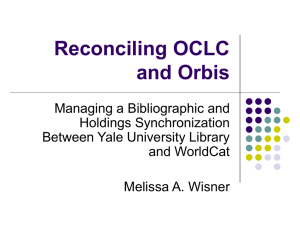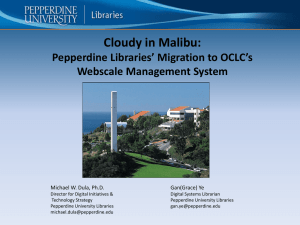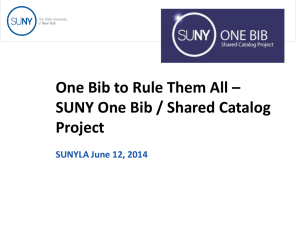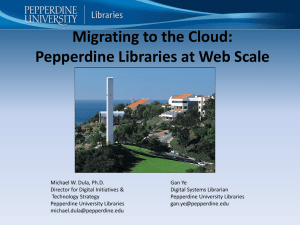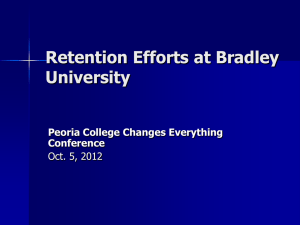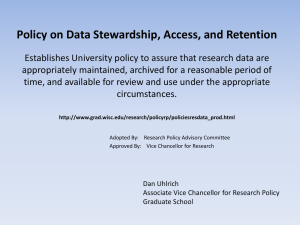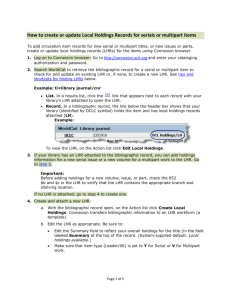Shared Print Management
advertisement
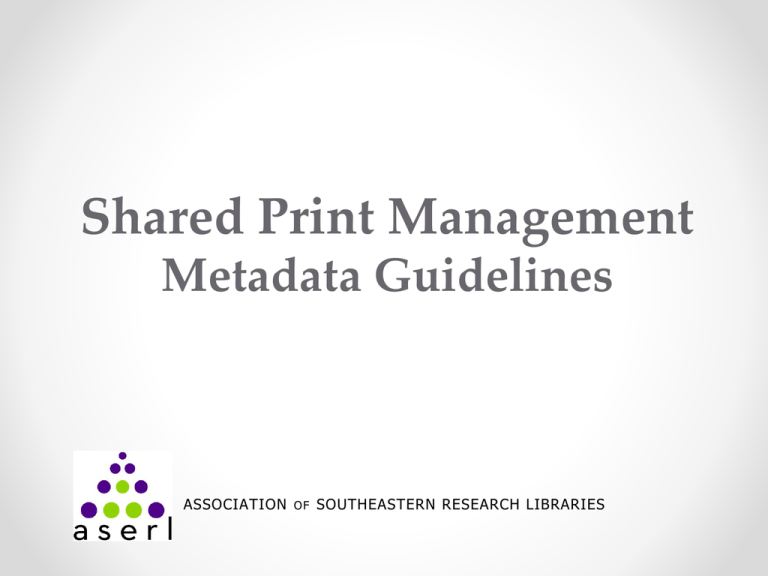
Shared Print Management Metadata Guidelines ASSOCIATION OF SOUTHEASTERN RESEARCH LIBRARIES 2010-2012 Pilot Project OCLC project to develop and test recommendations for how libraries could use Worldcat to register content contributed to shared print archives. http://www.oclc.org/productworks/ shared-print-management.htm Three Key Recommendations • Define separate OCLC Institution Symbols to identify print archived titles in facilities and full-service libraries. • Enter holdings-level print archives data in MARC Holdings records (OCLC LHRs). • Use the 583 Preservation Action Note to describe specific characteristics of the print archives action(s) for each set of holdings. A separate OCLC Institution Symbol – the pros • To readily identify the shared print status of a title at the title level – facilitating interoperability with ILL, collection analysis and aggregating shared print resources in group catalogs. • To indicate that a title is subject to some form of a retention commitment at a given institution. • To allow the library or shared print program to define different lending behaviors for these items compared to materials in the general collection or storage facility. A separate OCLC Institution Symbol – the cons The OCLC symbol is assigned to each institution rather than to the Archive (decentralized collections). Costs • Cataloging: o A new subscription is not required when an existing full cataloging subscription is in place. o One-time LHRUS set-up fee to batchload local holdings ($345). • Resource sharing: o If library is using WCRS – an annual lend-only subscription is required for the new symbol ($300/year). o If the library is using ILLiad – an annual ILLiad satellite license fee is required ($1200/year). • Group catalog – o The OCLC recommended approach is to establish a group catalog for each archiving program to facilitate local and group collection management decisions. There is currently no process to view holdings attributed to the shared print archive without implementing a group catalog. • Unknown o Staffing - change in workflow processes for cataloging and resource sharing. o Impact on future cataloging/WCRS subscription rates. o Development of the OCLC Shared Print Management model. Model just completed Phase I (Guidelines), changes are likely as they move into Phase II Use of LHRs LHRs are used to identify copy-specific, separate holdings records in OCLC for print resources subject to a retention commitment. • There are two approaches to creating LHRs o Manually using OCLC Connexion Browser (Connexion Client does not currently support this function). o Standard OCLC batch load processes. Note: OCLC does not accept holdings data embedded in bibliographic records. Use of the 583 To record information about preservation actions. For shared print initiatives, it is used to record print retention commitments and related actions. 583 Action Notes • $a -Action and type of physical review undertaken (retained, condition reviewed, completeness reviewed). • $d - Date the retention commitment expires. • $5 - Institution making the retention commitment. • $f - Authorization (the print archive program to which the materials are contributed). • $i - Validation level (none, volume, issue, or page level). • $z - Outcomes of validation (missing volumes, issues, presence of reprints, tight bindings, damage). • $3 -Materials specified (holdings to which action applies). • $u - Uniform Resource Identifier (link to program documentation for print archiving program). How many Action Notes? 1. At minimum, the LHR will contain one 583 action note to identify the retention commitment (“committed to retain”) and the retention period. 2. If the resource has been review for completeness, a second 583 action note is included (“completeness reviewed” and the outcome of that review (missing units, binding anomalies, reprints). 3. If the resource has been reviewed for condition, a third action note is included (“condition reviewed”) and the outcome of that review. Base Level For an unvalidated journal (no indication of holdings or condition) • • • • • • The first indicator should be set to 1 (meaning not private). $a (action) = “committed to retain”. $c (time and date of action) = “YYYYMMDD”. $d (Action interval, i.e. date when commitment expires) = “December 31, 2035”. $f (Authorization, i.e. name of archiving program) = “ASERL-WRLC”. $u (Uniform Resource Identifier, i.e. link to program documentation for the print archiving program identified in $f) = http://www.aserl.org/programs/j-retain/. Base-Level Example One 583 action note is required. 583 1# $a committed to retain $c 20120123 $d 20351231 $f ASERL-WRLC $u http://www.aserl.org/programs/j-retain/ Mid-Level For validated journal reviewed for completeness (indication of holdings, not condition). Two 583 action notes are required; a retention 583 (using the above subfields) plus a completeness 583, using the following subfields • • • • • • • • The first indicator should be set to 1 (meaning not private). $3 (materials specified, holdings to which action applies. Should be the same as described in LHR 85x/86x or 866). $a (action) = “completeness reviewed”. $c (time and date of action) = “YYYYMMDD”. $f (Authorization, i.e. name of archiving program) = “ASERL-WRLC”. $i (Method of action, i.e. validation level – volume-level, issue-level, pagelevel). $l (Status) = standardized language to describe units – changes in binding, missing issues or reprints, etc.). $z (public note, used to identify completeness problems, i.e. gaps). Mid-Level Example Two 583 action notes are required. • Retention: 583 1# $a committed to retain $c 20120123 $d 20351231 $f ASERL-WRLC $u http://www.aserl.org/programs/jretain/ • Completeness: 583 1# $3 v.1-v.32 (1949-1981), v.34-v44 (19831993) $a completeness reviewed $c 20120123 $f ASERL J-retain $i volume-level validation $l missing volumes $z missing v.33 High-Level For validated journal reviewed for both completeness and condition. Three 583 action notes are required; a retention 583, a completeness 583 and a condition 583, using the following subfields • • • • • • • • The first indicator should be set to 1 (meaning not private). $3 (materials specified, holdings to which action applies. Should be the same as described in LHR 85x/86x or 866). $a (action) = “condition reviewed”. $c (time and date of action) = “YYYYMMDD”. $f (Authorization, i.e. name of archiving program) = “ASERL-WRLC”. $i (Method of action, i.e. validation level – volume-level, issue-level, pagelevel). $l (Status) = standardized language to describe condition such as “acidic paper”, “tight bindings”, etc. $z (public note, used to identify condition problems, i.e. “tight bindings”, etc., followed by unit to which it applies). High-Level Example Three 583 action notes are required. • Retention: 583 1# $a committed to retain $c 20120123 $d 20351231 $f ASERL-WRLC $u http://www.aserl.org/programs/jretain/ • Completeness: 583 1# $3 v.1-v.32 (1949-1981), v.34-v44 (19831993) $a completeness reviewed $c 20120123$f ASERL-WRLC $i volume-level validation $l missing volumes $z missing v.33 • Condition: 583 1# $3 v.1-v.32 (1949-1981), v.34-v44 (19831993) $a condition reviewed $c 20120123 $f ASERL-WRLC $i volume-level validation $l tight bindings $z tight bindings v. 18v.21 (1967-1971) Our Recommendations • Continue to use existing OCLC institution symbol. • LHRs are “best practice”, not required. • Require: Base-level 583 Action Note in local catalogs. o 583 Action Note to OCLC as best practice but not required. • Recommend: Mid-level 583 Action Note in local catalogs • 583 Action Note to OCLC as best practice but not required. • For Discussion: High-level 583 Action Note in local catalogs.
